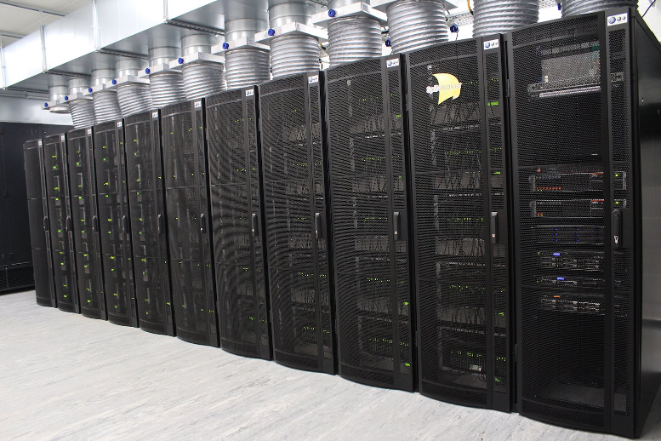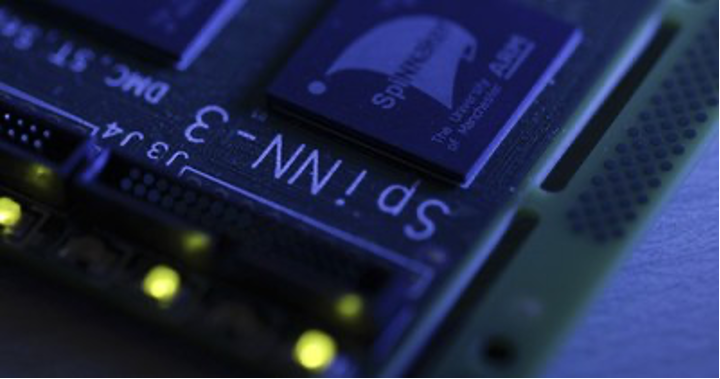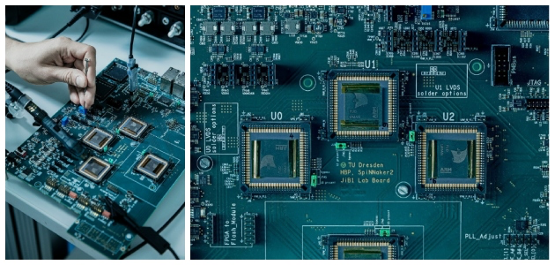- Interview
Neuromorphic Computing and the Human Brain Project: An Interview with Prof. Steve Furber on SpiNNaker and Cross-Disciplinary Brain Research
01 September 2023

Professor Steve Furber is a researcher and group leader at the University of Manchester. He has had a long career as a computer scientist and hardware engineer. Within the Human Brain Project (HBP), he has worked within the focus area of neuromorphic computing and as a member of the Science and Infrastructure Board. We spoke about how these disciplines can help reach a better understanding of the human brain.
What are you currently working on?
My group at the University of Manchester is primarily involved with the HBP in the neuromorphic computing area. We are responsible for SpiNNaker, which is one of the two large-scale neuromorphic computing platforms made openly available to the European community and beyond, under the auspices of the HBP.

What is SpiNNaker and what does it do?
In many ways, SpiNNaker is similar to a supercomputer. It has a million quite small processors. But unlike a supercomputer, which would tend to have very powerful number-crunching processors, SpiNNaker has small embedded processors, such as the kinds you find in your mobile phone. These are connected through a bespoke interconnect fabric which allows them to achieve the very high degree of connectivity found between neurons in the brain. On SpiNNaker, each of those million processors can support models of a few hundred neurons and they operate in biological real-time. Thus, the model on SpiNNaker usually runs at about the same speed as the biological system that it is modelling.

So it's almost like you're creating a sort of digital twin of the brain that allows you to do all these experiments and examinations?
Yes, in some ways it is like that. Of course, the models that we run on SpiNNaker are relatively simplified compared with the biology. A biological neuron is a very complex cell, which to model in detail takes a formidable amount of compute power. What we do is build on the work that's been done by generations of computational neuroscientists in defining simplified abstractions of biological neurons that aim to capture the functionality of the neuron as an information processing element, whilst ignoring most of the detail of the cellular biology of the neuron.
What are the advantages of this compared to other methods of researching?
The advantages are that SpiNNaker allows the user to build very large-scale models of brain subsystems that still execute a reasonably high level of performance comparable with the biology itself. And this has been used in the HBP to build models of various brain sub-regions such as the cortical microcircuit, cerebellum, basal ganglia and so on. Now I should point out that even with a million processors we don't get anywhere near the scale of the full human brain. Optimistically, we can model approaching perhaps one percent of the human brain, or maybe 0.1 percent. So we're not here claiming that we can run full human brain models on SpiNNaker.
But SpiNNaker allows users to explore hypotheses and theories about how the brain might work. Because the way the brain works as an information processor is still a mystery to science, and it's one of the grand challenges of neuroscience to try and begin to use compelling explanations of how the brain does its job. But until such explanations are available, the science progresses by people putting forward theories and testing those theories, and a computer model is a good way to test a theory.
What has been the impact or involvement with the HBP in terms of your work? Do you think cross-disciplinary collaboration creates a more fruitful work environment or project outcome?
The HBP has put us in a very broad community spreading from electronic engineers at our level at one end right through computational neuroscientists to lab neuroscientists and medical neuroscientists. In building a machine to contribute to brain research it's been extremely useful to have access to people working in that area. The various brain region models that I described earlier are all the results of collaborations within the HBP, with both computational and wet lab neuroscientists and, of course, theoretical neuroscientists, or the people who generate the hypotheses that SpiNNaker is well-placed to test, to see if the theories of brain function can be borne out by models running suitable algorithms on SpiNNaker. It's been both very well timed and extremely useful to our work to form these collaborations with groups across the HBP over the 10 years that the project has been running.
Listen to an extended version of this interview below:
See also: The next generation of SpiNNaker powers energy-efficient AI applications




